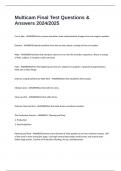Tentamen (uitwerkingen)
Multicam Final Test Questions & Answers 2024/2025
- Vak
- Instelling
Multicam Final Test Questions & Answers 2024/2025 Cut or take - ANSWERSMost common transition; least noticed;instant change from one image to another. Dissolve - ANSWERSGradual transition from shot to shot; shows a change of time or location. Wipe - ANSWERSTransition that interjects inte...
[Meer zien]



